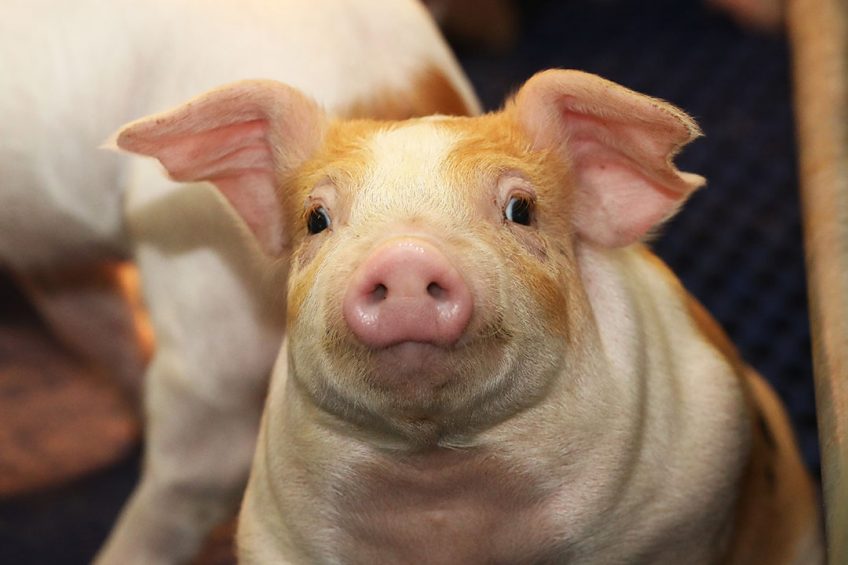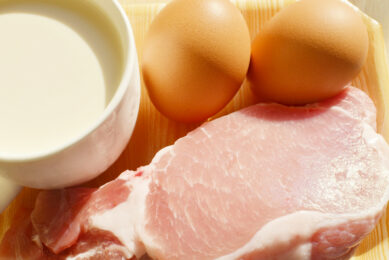Management tips for reducing antibiotic use

A complete ban on the use of antibiotics in pork production, given the current level of knowledge and technology, is impossible. Nonetheless, it is a highly desirable goal to reduce the use of medically important antibiotics to the lowest possible level. The correct feeding and management practices can help in achieving this.
The evolution of antibiotic-resistant pathogens is considered a matter of grave concern in human medicine. A related concern is antibiotic residues found in meat, milk and eggs. This is one of the vehicles by which antibiotic-resistant bacteria develop and can be transmitted to the human population. The incidence of antibiotic residues in pork appears to be very low, although it could vary by geographical region.
The solution accepted by most nations to reduce the risk of selecting for resistant bacteria, is to reduce antibiotic use, both in human medicine and in meat, milk and egg production. Outright banning of antibiotics for use in animals is widely recognised as extreme and imprudent as it ignores the welfare of animals that have become infected by a pathogen. Consequently, in order to reduce the use of antibiotics in meat, milk and egg production, the current logic recognises more focused use of specific antibiotics for specific purposes.
Reducing the use of antibiotics in pork production is an important goal to help address the issue of antibiotic resistant pathogens causing illness and death in the human population. Certainly, some animals can be, and are, raised to market under antibiotic-free conditions. However, this generally refers to a portion of animals from a farm that did not require antibiotic treatment and can therefore be considered ‘antibiotic free’. The suggestion of raising all pigs antibiotic free ignores the fact that some pigs will require prophylactic treatment to recover from illness and survive, and will be removed to a different flow of animals that no longer meet the ‘antibiotic-free’ standard.
Defining the cost requirements
The reduced use of antibiotics in pork production is possible. To accomplish this goal, though, the cost needs to be defined and the objectives clarified. The sole objective of reducing antibiotics in pork production would be reduced antimicrobial resistance in medications used in human and animal medicine. The objective favouring continued use would be maintenance of animal welfare and reduced cost of food to the general public. The cost is significant, at least with our current knowledge and understanding of antibiotic-free production. For example, Main et al. (2010) compared antibiotic-free production (AFP) versus conventional management. There were 108,000 pigs involved in the AFP system and 611,000 pigs in the conventional system; all pigs originated from the same sow production pyramid.

The AFP pigs were weaned 5 days later than conventional, received an all-vegetable diet, received numerous vaccines and were given more floor space than that used in normal production. As expected, the growth rate was poorer and mortality was considerably higher. The researchers calculated that the added cost of AFP was about $ 11 per pig sold, and that most of the costs accrued prior to the pigs reaching 23kg. Indeed, growth performance was similar in both systems during the grow-finish period. Another study concluded that the cost of production would increase by 14 to 21%, based on current assumptions of changes in inputs, performance and outcomes. Numerous analyses of reduced antibiotic usage (RAU) and AFP production systems all reached the same conclusion – that mortality is the main driver of increased cost and thus needs to be a focus to make RAU and AFP sustainable in the long term.
Antibiotic use and pig management
Efforts to achieve RAU in pork production involve a multidisciplinary approach involving genetics, health management, building engineering design and operation, animal husbandry and nutrition. At the top of the list would be enhanced building hygiene, including better biosecurity. Reducing the exposure of pigs to the number of pathogens as well as the frequency and intensity of the contact, is crucial to success.
Porcine Reproductive and Respiratory Syndrome virus (PRRSv)
In North America it is generally accepted that RAU will only be truly effective when pigs are free of the Porcine Reproductive and Respiratory Syndrome virus (PRRSv). The presence of this virus makes RAU much more difficult to implement. As technology improves, and our understanding of the physiology and immunology of the pig advances, this restriction may be less important, but at the present time, it is considered essential for RAU’s success.
Batch farrowing
Batch farrowing has grown in popularity as a means of reducing the age variation within a population of pigs, and thus enhancing the ability of barn staff to control pathogen exposure. Variation in age makes this much more difficult. Batch farrowing also helps the farm follow another key feature of success, namely no co-mingling of pigs of different ages within a given space, or ideally, a given site.
Newborn piglet & newly weaned pigs
Experience over the past decade suggests that greater attention to the newborn piglet and newly weaned pigs is another important step to RAU. This includes focused vaccination programmes that provide protection to the animals prior to pathogen exposure or illness. It also means intervention with an individual antibiotic or other therapeutic treatment at the first sign of illness, since early treatment is known to be most effective. Adopting RAU may require an increase in the age at weaning, as it is well-know that the traditional 3-week weaning exposes piglets to social, nutritional and immunological stress at the worst possible time physiologically.
Isolated area for sick pigs
An isolated area for sick pigs needs to be established, and all animals showing signs of illness must be removed to this location as soon as they are identified. This will help to reduce the infection pressure placed on other healthy animals. Finally, when all animals in a room must be treated, water would be considered the method of choice. Treatment can be implemented more rapidly than via the feed and the use of antibiotics can be reduced to the minimum needed.

Antibiotic use and diet
Diet formulation and composition are critical components of RAU systems because feed can predispose the pig to digestive upset and can serve as a vehicle for the delivery of products that offer some degree of protection to the pig.
‘Functional’ properties of ingredients
Increasingly, the evaluation of ingredients for use in pig diets will extend beyond the traditional consideration of nutrient supply and palatability; it must include what might be called ‘functional’ properties of ingredients as they relate to effects on the structure and function of the intestinal tissue, the microbiome, oxidative stress, and immune function.
Soybean meal
Soybean meal offers a bit of a conundrum to nutritionists. Generally, the level of soybean meal used in phase 1 and 2 starter diets in North America, is limited to 15 and 20% respectively, due to the immunological effect of certain proteins such as glycinin and β-conglycinin on intestinal tissue and the immune system. Glycinin and β-conglycinin represent 65 to 80% of the protein in soybean meal. Consequently, other protein sources are used in weanling diets, such as enzyme-processed soybean meal, fermented soybean meal, fish meal, yeast protein, etc. It is also known that when pigs are weaned at 4 weeks of age or greater, their sensitivity to soybean proteins declines. In RAU systems, levels of soybean meal may have to be further restricted to minimise pressure on the intestinal health of the newly weaned pig, or weaning age will have to increase.
Minimising nutritional stress
In addition to considering the functional properties of individual ingredients, there is also the issue of formulating diets to minimise nutritional stress on the pig, with particular emphasis on its intestinal tissues.
Proteins
For example, it is well known that excess protein in the diet will encourage post weaning diarrhoea. Lower protein diets are therefore recommended. Individual amino acids may also play a role in weanling pig health and performance. Glutamine and glutamate are both effective sources of energy for enterocytes and have been proposed as valuable in the diet of the young pig, in particular as a means of minimising intestinal atrophy, a common observation at the time of weaning. However, experimental evidence of actually improving pig performance is inconsistent, so glutamine/glutamate supplementation has not become a common commercial practice. Alanine and glycine appear to stimulate release of the so-called anti-secretory factor that provides protection against diarrhoea, but again, are not yet routinely added to commercial diets.
Zinc oxide
Zinc oxide has proven to be highly beneficial in the control of post-weaning diarrhoea (PWD) when fed at levels of 2.4 to 3g/kg for a period of no more than 2 weeks. Indeed, zinc oxide levels should be reduced by 50% in the second week to achieve maximum overall pig performance.
Organic acids
Organic acids, such as citric, fumaric, propionic, formic, lactic and benzoic, are also used in RAU systems. There is an inconsistency in study responses, which suggests more needs to be known about the mode of action of such products, and the conditions under which they will be most effective. Nonetheless, organic acids are one of the most commonly used feed additives in RAU situations.
Microbials
Direct fed microbials (DFM), previously referred to as probiotics, contain live, viable bacteria – typically lactic acid generating species, bacillus and sometimes yeasts. They have been shown to impair pathogen adhesion to the gut wall, and to inhibit the production of bacterial toxins. Prebiotics are components of feed that are generally indigestible by the pig, but which support the proliferation of a more favourable microbiome, including Lactobacillus spp. and Bifidobacterium spp., to competitively inhibit pathogenic species. Synbiotics represent blends of direct fed microbials and prebiotics.
Benefits of nutritional supplements
The use of exogenous enzymes in pig diets is generally used for their role in the breakdown of dietary components that otherwise escape digestion in the monogastric environment. However, there is a growing understanding that certain enzymes may achieve more than simple improvement in diet digestibility or pig growth. Mortality is notoriously difficult to study using classical experimental approaches, because very small differences, generally of considerable economic merit, are difficult to detect with statistical significance unless very large numbers of animals are used. Nonetheless, a recent study from the Hanor Company reported a linear reduction in mortality as xylanase concentration increased. Even with 2,124 pigs involved, and mortality declining from 3.99 to 2.39%, the P-value for this difference was only 0.175.
Finally, nutritionists’ understanding of the role of fibre in the diet is rapidly expanding. It is becoming clear that different fibres have different impacts on the gut of the pig. Furthermore, the effect is dependent on the type of fibre involved and the pathogen of interest. Fibre that is insoluble and poorly fermented tends to increase rate of passage and have possibly abrasive effects on the lining of the intestine. Both these factors may benefit the pig by impeding adhesion of pathogens to the intestine infrastructure, resulting in reduced incidence and severity of diarrhoea. Conversely, more soluble and fermentable fibre appears to impart prebiotic effects on the intestine, resulting in less severe diarrhoea. In the case of colibacillosis, the more fermentable fibre is preferred.
References available on request
This article has been edited and reprinted with permission from AFMA Matrix (July-Sept issue 2019).






